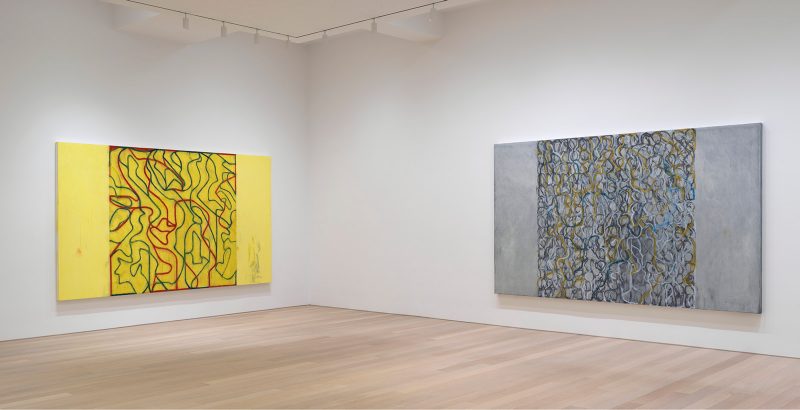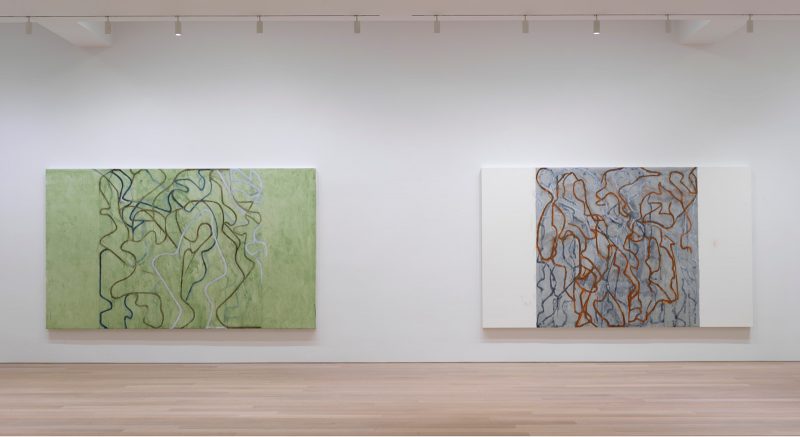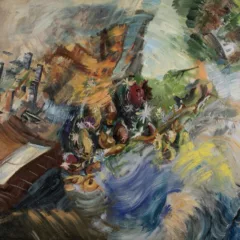
Artwork © 2019 Brice Marden/Artists Rights Society (ARS), New York. Photo: Rob McKeever. Courtesy Gagosian.
It’s growing colder and darker these days and the artworld, all who can afford it, has flown to Miami, a city that is not yet submerged in the just-arriving floods. There in Florida, with props as simple as a comedian’s banana, a handyman’s tape, and a socialite’s copious boredom, they seem to be reenacting, for the umpteenth time, the ancient ritual of dada in which, alas, the punchline/catharsis occurs when the prank is memed and monetized and the triumph of the marketplace is affirmed. Ha-ha-ha. Ka-ching. (And Marcel Duchamp spins in his grave like a chocolate grinder.)
In these dark days, there’s much to despise about the artworld and there’s plenty that’s positively disgusting about the ways that dealers, collectors, and artistes have turned it into a vapid exercise in the hedging of status. (The Price of Everything, a recent documentary, is mandatory viewing for anyone who is new to this notion.)
And yet, perhaps because the darkness of our moment is in no way limited to the artworld, I return to the galleries again and again. I go as often as I can, in fact, to see what is there, to take the pulse of the artworld and see if I can detect a thump or flutter. I return, it has been observed, like a hungry bird returning again and again to the same empty feeder. Cheep-cheep.
It was on just such a trek that I found myself at Gagosian on Madison Avenue and encountered Brice Marden’s new work, part of his show It reminds me of something, and I don’t know what it is. The six large paintings that occupy one of the show’s two galleries made me feel my own heart as well as the pulse of a vibrant artworld. If you happen to be in New York between now and the 21st—or if you can get there—I heartily recommend these works to you. And the rest of the show, too.
While abstraction can be cold—and is often intended to be so—Marden has always insisted on a “romantic” (his word) attitude toward artmaking even when he was considered part of the cool minimalist movement that was the rage when he came to New York in the 60s. As early as his graduate student days at Yale, he asserted that he was making “highly emotional paintings not to be admired for any technical or intellectual reason but to be felt.

Artwork © 2019 Brice Marden/Artists Rights Society (ARS), New York. Photo: Rob McKeever. Courtesy Gagosian.
Marden came out of BU, where he was steeped in traditional technique, and Yale, where he became committed to abstraction. He moved to New York in the mid 60s and worked as a guard for the Jasper Johns retrospective and, later, spent four years as Rauschenberg’s studio assistant. He became known for monochromatic canvases made of beeswax mixed with paint, applied with a plasterer’s precision to the canvas. After a long period in which he attached these panels to one another, marrying as many as 18 separate monochromes together, his process underwent a sea change in the mid 80s, when he became captivated by Asian calligraphy. In the loose glyphs of the master calligraphers, Marden felt what he calls “pure expression” and he began to be able to integrate his longtime drawing practice into his painting. Over thirty-five years, he’s developed a highly sophisticated vocabulary of building his pictures off of grids of calligraphic glyphs painted on color fields, painting (and scraping, and repainting) over these with tendril-like lines that stretch and loop and overlap while, generally, respecting the image’s edge. And always in Marden there is color, in the field and in the line: strong, delicious, seductive color—even in his early work, when the colors were chiefly grays and blacks.
The show at Gagosian features six large canvases—each is six feet by ten—that exemplify the best of this mode of working, even as they seem to be opening up thrilling new directions for Marden, who is over eighty. Each is composed of a central square which is heavily painted in the style exemplified by the calligraphy-inspired Letter series, flanked by vertical strips that function as “offstage” for Marden. He uses these “wings” sometimes to extend the color field that grounds the main event and, on other canvases, to set it off. Often there are drips or wipes or other evidence of process populating the wings and, in a few cases, the artist actually allows his lines to wander a bit out of the square and into the wings. These stray tendrils give his images an “outside the box” resolution and indicate Marden’s fresh impulse to set the rules of his abstraction aside to gain the freedom to paint with a surprising new spontaneity.

Artwork © 2019 Brice Marden/Artists Rights Society (ARS), New York. Photo: Rob McKeever. Courtesy Gagosian.
“March,” the most captivating of these six spectacular works, is also the sparest. Its wings are the closest to pure white, the least marked by the artist’s working, and maintain a steadfast (if not crisp) border between the centered square and the periphery. The square itself is divided into a grid of 15 by 15 squares, not (that the eye can see) by calligraphic markings, but by pencil lines, which are plainly, shockingly (for Marden), apparent. The underlayer is loose and thin, a pale bluesy gray. And the surface colors are white and orange, blackish blue and sea blue, the latter touching somewhere close to the center of many (or all) of the gridded squares. The composition, the pathways of Marden’s veins, is derived, familiarly, in touching and connecting and finding trajectory and shape from his sense of how the grid falls.
What’s new here, and in others of this lot of works as well, is that the lay of the line is sung more subtly; Marden’s hand is confidently more provisional. He isn’t camped out within the long march of a set of procedures; the work seems quick and spirited, the lines are less sculpted and more alive to the moment of their creation. And the possibility of their oblivion: for everything here is thrillingly fragile. Where there are erasures and re-coverings they are done in the open, with thinner and quick re-touchings that occupy a fair amount of the surface. Here, every correction is embraced as an essential mark; each false start is made true.
The texture of the linen is discernible across the surface. The pencil grid is on the plane. For thirty five years, Marden has been a kind of passionate virtuoso of the picture plane and a master of arduous processes to mine each surface for all the non-illusory depth one could imagine. Here, he’s stepping away from that virtuosity to work more simply, more nakedly, with a brazen humility and an infectious adoration of his craft.
It’s a thrilling, high-stakes move that pays off brilliantly, enough to rejuvenate one’s taste for this whole endeavor.
Brice Marden “It reminds me of something, and I don’t know what it is.” Gagosian, 980 Madison Avenue, New York, NY, Nov 9–Dec 21, 2019









